| کد مقاله | کد نشریه | سال انتشار | مقاله انگلیسی | نسخه تمام متن |
|---|---|---|---|---|
| 5781286 | 1636003 | 2017 | 61 صفحه PDF | دانلود رایگان |
عنوان انگلیسی مقاله ISI
Supercritical-flow structures (backset-bedded sets and sediment waves) on high-gradient clinoform systems influenced by shallow-marine hydrodynamics
ترجمه فارسی عنوان
ساختارهای جریان فوق بحرانی (مجموعه های کم پشتی و امواج رسوب) در سیستم های کلینوفور بالا گرادیان تحت تأثیر هیدرودینامیکی کم عمق دریایی
دانلود مقاله + سفارش ترجمه
دانلود مقاله ISI انگلیسی
رایگان برای ایرانیان
کلمات کلیدی
موضوعات مرتبط
مهندسی و علوم پایه
علوم زمین و سیارات
فرآیندهای سطح زمین
چکیده انگلیسی
Inferred supercritical structures and bedforms, including sediment waves and backset-bedded sets, are identified as components of coarse-grained siliciclastic and bioclastic, high-gradient clinoform wedges (Plio-Pleistocene of southern Italy) and canyon head infills (Tortonian of Venetian pre-Alps), showing evidence of having been built out in a setting influenced by shallow-marine hydrodynamics. The facies identified are dominated by a range of traction carpets, formed after segregation of coarser particles in the lower part of bipartite density underflows. The generation of backset-bedded sets is thought to imply scouring due to impact of a submerged hydraulic jump on the bed, and upstream migration of the jump, concomitant with the deposition of backset beds on the stoss side of the developing bedform. Submerged hydraulic jumps apparently formed spontaneously and in any position on the foreset and toeset, without requiring any precursor bed defect. The mostly solitary, non-cyclical character of the bedforms prevents their attribution to cyclic steps. The sets of backset beds are locally underlain by chaotic infills of deep, steep-sided scours attributed to vigorous erosion at the hydraulic jump, accompanied by instantaneous loss in transport capacity which results in rapid plugging of the scour (hydraulic jump facies of Postma et al., 2014). Gravel waves have a distinct internal stratigraphy, and their length to amplitude ratios show lower mean values and higher variability when compared to sediment waves consisting of sand. The presence of supercritical bedforms on steep foreset slopes of the studied clinoform systems, even in proximity to the topset-foreset rollover, is believed to reflect high inefficiency of mud-poor and short run-out bipartite underflows episodically transporting relatively small volumes of coarse-grained sediment. This may also account for common solitary, non-cyclical bedforms. It is proposed that during intense oceanographic events, such as coastal storms, seaward sediment entrainment, assisted by gravity, was very effective on the gently sloping subaqueous topset, and that, beyond the topset-foreset rollover, the flows evolved to high-concentration turbidity underflows with supercritical Froude numbers. The flows are inferred to have been sustained, probably lasting for the duration of the meteorological events, and to have commonly been unsteady in discharge, fluctuating in concentration and size of transported sediments, and subject to peaks in velocity. The characteristics of the structures are regarded as typical of the systems fed by oceanographic processes, and may fall into the class of coarse-grained “small sediment waves with mixed relief” of Symons et al. (2016), formed from a combination of erosion and deposition, and by the action of stratified flows depositing from denser basal layers, and typically restricted to small-scale shallow-marine slope systems.
ناشر
Database: Elsevier - ScienceDirect (ساینس دایرکت)
Journal: Sedimentary Geology - Volume 360, October 2017, Pages 73-95
Journal: Sedimentary Geology - Volume 360, October 2017, Pages 73-95
نویسندگان
F. Massari,
